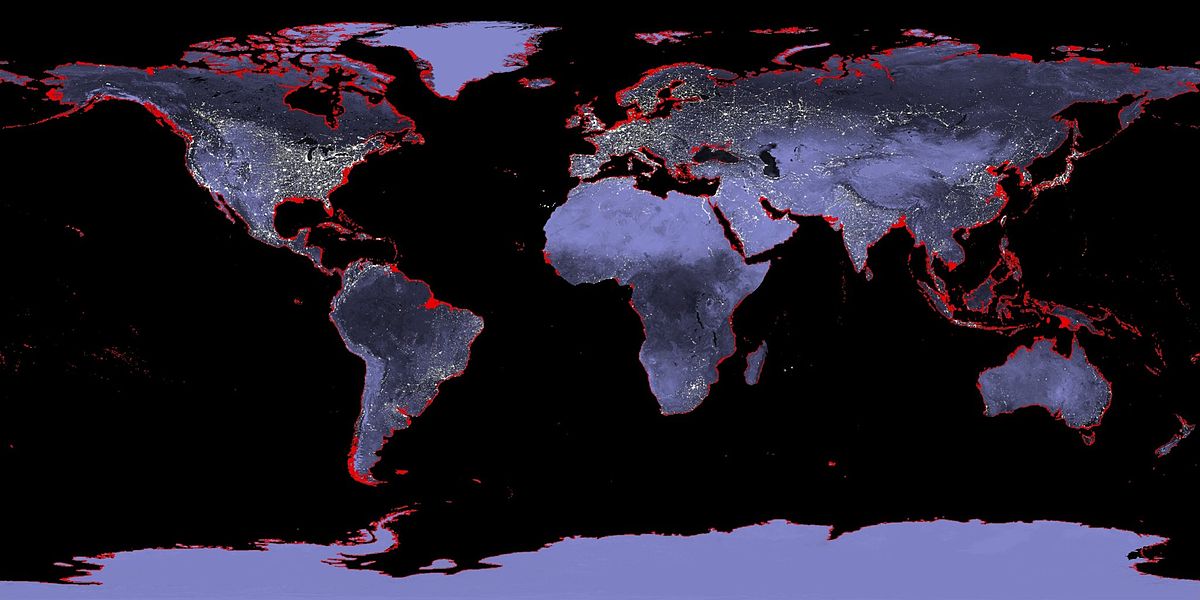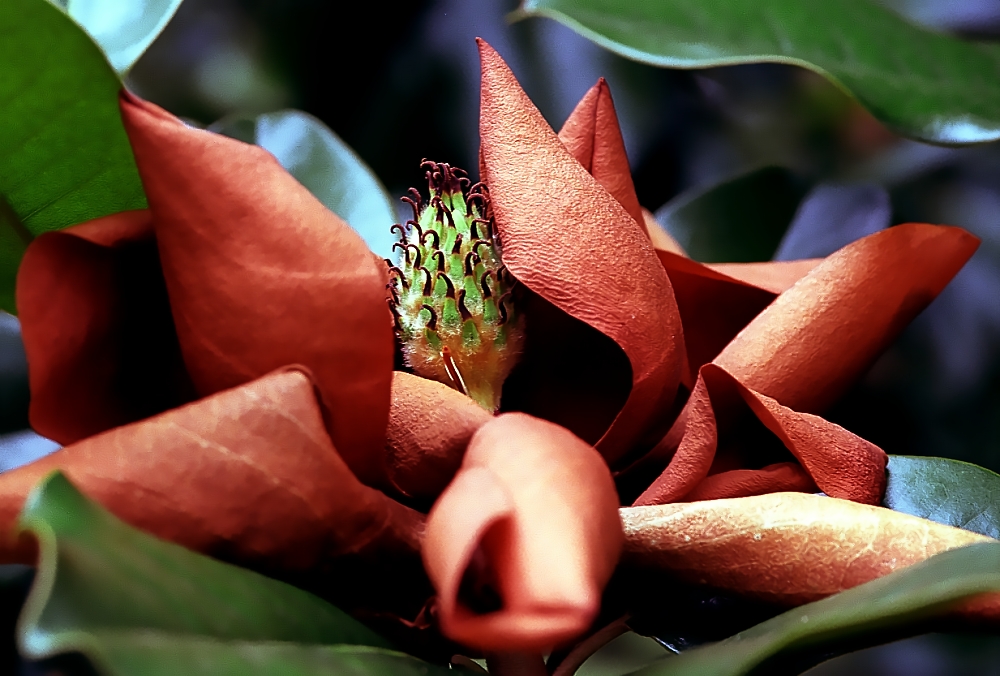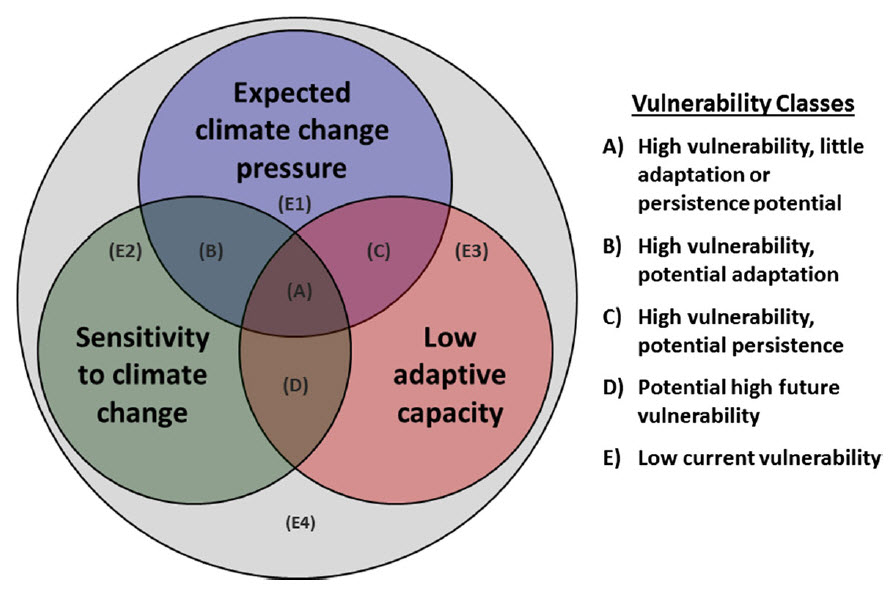Trees can do a lot of amazing things, but they can’t move away when the climate becomes inhospitable. Some can adapt to changing climate, and some can’t. Which species will be hit the hardest?
The most “vulnerable” species are those most susceptible to genetic degradation due to declining populations in the face of adverse environmental conditions. Genetic diversity is directly linked to resilience – that is, the capacity of any species to successfully evolve and adapt to change. More genetic diversity is better and necessary for long-term survival of any species.

Map of the Earth with a six-meter sea level rise represented in red) credit: By NASA – Public Domain
Climate change effects
The outdated phrase “global warming” doesn’t begin to express the complexity of climate change. We are certainly experiencing warming average temperatures (the decade from 2001 to 2010 was the warmest on record globally), but in certain areas record cold temperatures, extreme wet or dry seasons, and an increase in storm intensities are also occurring. Certain tree species have already begun to “migrate;” that is, to be found outside of their native range due to climate change. Others are undergoing “range contraction” and will decline unless conservation measures are taken.
USDA Study methodology
Helpfully, the US Forest Service and North Carolina State University (NCSU) have recently published the results of a study in the journal New Forests that identifies the most vulnerable tree species by analyzing three factors, or dimensions:
- Expected climate change pressure (threat exposure): The intensity of the climate change that may be experienced by any one species. Contributing factors include habitat range stability and distance to other suitable habitats.
- Sensitivity to climate change: The potential response of a certain species to the threat. Contributing factors include species rarity, area of distribution, dispersal ability and tolerance of disturbance.
- Low adaptive capacity: evolutionary resilience to a climate change threat. Contributing factors include regeneration capacity (seed viability, reproduction strategies, etc), existing genetic variability and ecological requirements.
339 native forest trees were scored on each dimension on a scale from 1 to 100 where higher scores indicate higher levels of vulnerability. Most of the data was already available from public sources including the USDA PLANTS Database, Trees were ranked into “vulnerability classes” depending on how many dimensions were scored at 40 or above. Dimension scores were averaged to determine an overall score.
As shown in the photo above, the most vulnerable tree species scored high in all three dimensions (Class A), while the lowest ones scored below 40 in all dimensions (Class E4).
Results
Here are the top 5 species in Vulnerability Class A, (i.e., the most vulnerable):
- Water locust (Gleditsia aquatica) – native to the American Southeast
- Texas walnut (Juglans microcarpa) – native to Texas, New Mexico, Kansas
- Chalk maple (Acer leucoderme) – native to the American Southeast
- Pyramid magnolia (Magnolia pyramidata) –native to the American Southeast
- Two-wing silver bell (Halesia diptera) – native to the American Southeast
Here are the bottom 5 species in Vulnerability Class E4 (the least vulnerable):
- Paper birch (Betula papyrifera) – Native to northern N. America (Canada, Alaska)
- Utah juniper (Juniperus osteosperma) – native to the Western US
- Ponderosa pine (Pinus ponderosa) – native to the Western US
- Red alder (Alnus rubra) – native to the Western US
- Water oak (Quercus nigra) – native to the American Southeast
Is the American Southeast more likely to lose its forests than the Western United States? Maybe yes, maybe no. An analysis of specific native habitats for each species would tell us more.
Some popular trees and their rankings
(Taken from Supplementary Table 2 available for download from https://link.springer.com/article/10.1007%2Fs11056-017-9569-5)
Vulnerability Class B (high vulnerability, potential adaptation):
- Kentucky coffeetree (Gymnocladus dioicus)
- Giant sequoia (Sequoiadendron giganteum)
- Joshua Tree (Yucca brevifolia)
Vulnerability Class C (high vulnerability, potential persistence):
- Southern Magnolia (Magnolia grandiflora)
- American basswood (Tilia americana)
- Black walnut (Juglans nigra)
Vulnerability Class D (potential high future vulnerability):
- Monterey cypress (Cupressus macrocarpa)
- Live oak (Quercus virginiana)
- Bristlecone pine (Pinus aristata)
Vulnerability Class E (low current vulnerability):
- Coast redwood (Sequoia sempervirens)
- Red maple (Acer rubrum)
- Sweetgum (Liquidambar styraciflua)
How can this information help us?
Managers of large tree populations with limited budgets might use this information to prioritize spending their money on planting and caring for tree species with the lowest scores, i.e. the highest potential for surviving climate change. Managers of arboreta or germplasm repositories (or even private property owners) might focus their budget on preserving the most vulnerable species for as long as possible.
Remember that these are analyses of native forest trees in forest habitats. How these same trees would be scored in urban growing conditions may differ. Climate change stresses will also vary by region and microclimate. The results of this study, combined with local knowledge and professional judgment, will help tree managers help trees in the face of a changing climate.
Ellyn Shea is a consulting arborist in San Francisco.








I am surprised to see Ponderosa pine on the list of “least vulnerable” species. 102 million conifer trees in the Sierra Nevadas in California died during the recent 5-year drought. Ponderosa pine was one of the tree species that died. Most of the conifers were killed by a combination of drought and native bark beetle infestations. This species of bark beetles is not new to the region, but their population has spread because of the warming climate. Temperatures during the winter no longer drop enough to kill the beetles.
If this study only considered temperatures, it is not likely to produce meaningful results. Genetic diversity may be a factor, but it is not the only variable that predicts the future of our trees.The Ponderosa pine is just an example of a tree that is now vulnerable to insect pests that have spread because of climate change. The native shot-hole borer is killing off several species of native trees in Southern California. They will undoubtedly spread north in due time.
Tree diseases are another factor that must be taken into consideration. 5 to 10 million Coast Live Oak and Tanoaks have died in California because of Sudden Oak Death. That pathogen is spread by rain and wind, so torrential rains in the past 2 years have caused the disease to spread exponentially.
As this article says, climate change is more than changes in temperatures. It is an entire suite of changes in the climate and they will all have an affect on our trees. Meanwhile, native plant advocates demand that only native trees be planted where they existed hundreds of years ago, often in places where they can no longer survive.